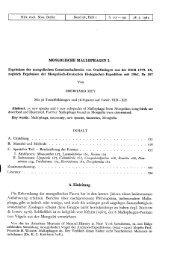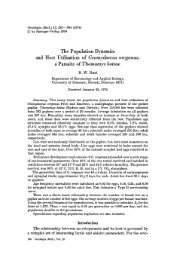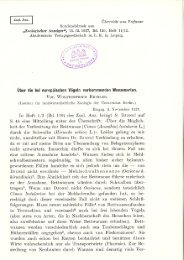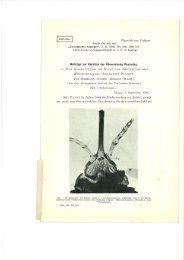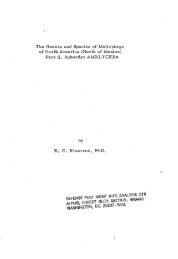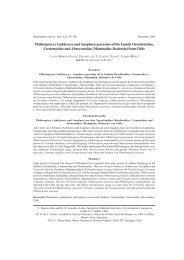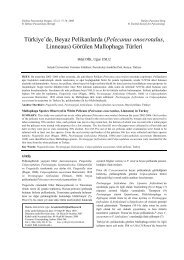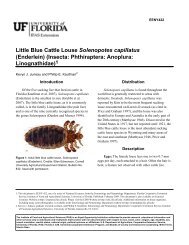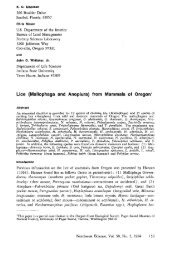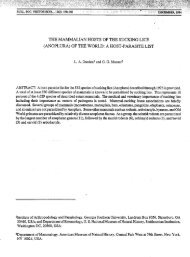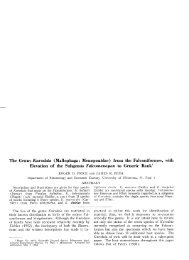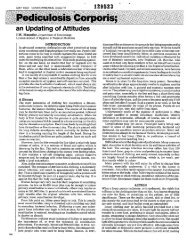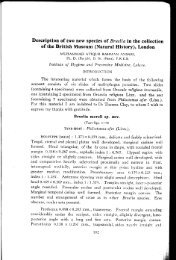The Geographical and Ecological Distribution of Arboreal Psocoptera
The Geographical and Ecological Distribution of Arboreal Psocoptera
The Geographical and Ecological Distribution of Arboreal Psocoptera
You also want an ePaper? Increase the reach of your titles
YUMPU automatically turns print PDFs into web optimized ePapers that Google loves.
Annu. Rev. Entomol. 1985.30:175-196. Downloaded from arjournals.annualreviews.org<br />
by Mr. Bas van Berkum on 10/10/07. For personal use only.<br />
Annual Reviews<br />
www.annualreviews.org/aronline<br />
180 THORNTON<br />
three-segmented tarsi, is unique in the family; it is primitive in several respects<br />
but has apomorphous characters in common with Elipsocidae. <strong>The</strong>se recent<br />
discoveries are <strong>of</strong> biogeographical <strong>and</strong> phylogenetic interest <strong>and</strong> underscore the<br />
incompleteness <strong>of</strong> knowledge, even <strong>of</strong> such a well-investigated are, a.<br />
Recent work on European Elipsocidae (29) has shown that Hemineura dispar<br />
occurs in Sc<strong>and</strong>inavia, Estonia, <strong>and</strong> Germany <strong>and</strong> at high altitudes in Switzerl<strong>and</strong><br />
<strong>and</strong> France <strong>and</strong> in Moravia. Badonnel regarded the species as a postglacial<br />
relict; its southern limit is in the mountains <strong>of</strong> southern France where two<br />
congeneric species also occur, H. bigoti <strong>and</strong> H. hispanica, the latter also<br />
known from Spain,. Whereas dispar evidently has two generations per year, at<br />
least in Moravia, the two Mediterranean species are univoltine winter species.<br />
Both are parthenogenetic, with apterous females, but they differ from one<br />
another in aspects <strong>of</strong> biology <strong>and</strong> behavior. It is possible that all three species<br />
are glacial relicts, since dispar alone has survived in the north <strong>and</strong> extended to<br />
high locations in the south <strong>of</strong> its range; the other two persist only in the<br />
northwest Mediterranean area where they have a long resting stage in the egg<br />
<strong>and</strong> a short active generation in winter.<br />
<strong>The</strong> Atlantic isl<strong>and</strong>s have also recently received considerable attention (35,<br />
37). <strong>The</strong> Canary Isl<strong>and</strong>s, which are nearest to the mainl<strong>and</strong>, have 28 species (10<br />
endemic), followed by Madeira, with 19 (4 endemic). <strong>The</strong> Azores have<br />
species (4 endemic), <strong>and</strong> only 3 species (2 endemic) are known from the<br />
Verde Isl<strong>and</strong>s. Atlantopsocus (Psocidae), a genus that occurs in the Atlantic<br />
isl<strong>and</strong>s, comprises three species <strong>and</strong> is known from Irel<strong>and</strong>, Morocco, the<br />
Canaries, Madeira, <strong>and</strong> the Azores. Its closest relative appears to be Camelopsocus<br />
(54), <strong>of</strong> which five species are known from western North America.<br />
Mesopsocus, which is well represented in northwest Africa, extends only to the<br />
Canaries, where one species is endemic; this genus, in which most species have<br />
flightless females, is also absent from Madagascar (below). Twelve psocopteran<br />
species (four endemic) are known from Saint Helena (7); three <strong>of</strong> these<br />
cosmopolitan <strong>and</strong> four occur in Northwest Africa <strong>and</strong> the Atlantic isl<strong>and</strong>s<br />
mentioned above, possibly introduced by Portuguese maritime activity. Of the<br />
endemics, three have closely similar counterparts in West <strong>and</strong> Central Africa,<br />
<strong>and</strong> one is evidently an older endemic <strong>of</strong> unknown affinities.<br />
Ethiopian Region<br />
Coverage <strong>of</strong> Africa has been patchy; almost 80% <strong>of</strong> the species are known only<br />
from the type locality. <strong>The</strong> known fauna totals 493 species, <strong>and</strong> its relationships<br />
with those <strong>of</strong> Madagascar <strong>and</strong> the Mascarene isl<strong>and</strong>s have recently been<br />
considered. In West Africa 160 species are known, in East Africa 155 (20, 21),<br />
<strong>and</strong> in southern Africa 239 species are recorded from Angola (9) <strong>and</strong> 90 from<br />
other areas. Africa is rich in a number <strong>of</strong> families while others that are well<br />
represented elsewhere, such as Lachesillidae <strong>and</strong> Philotarsidae, are absent or<br />
have only few species.



